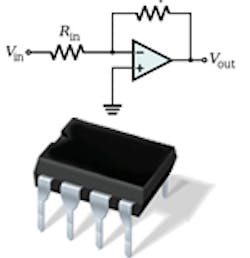They might not be as sexy as the latest MEMS gyro or A/D converter, but amplifiers are hidden heroes, performing the real and necessary functions in most electronic systems.
Because of this near ubiquity, they are particularly good bellwethers of industry trends. Two key trends that have been steadily growing for years and are poised to gain significant momentum in 2012 are the migration towards zero- drift capability and the much greater range of voltages that will be seen at the supplies and the inputs. Supply voltages have been decreasing as silicon geometry shrinks and the green revolution demands more accurate measurements of supply currents at any voltage.
We often take for granted that amplifiers can handle any input signal voltage from microvolts to beyond the power supplies, operate on almost any voltage, and output a signal that can drive the following stage.
At the same time, the amplifier must protect the system from anything that could be connected to the input purposely or accidentally. Consider that plugging in an ear phone could produce static charges of thousands of volts to an amplifier input.
The continued migration of configurations and functionality, from single amplifiers into functional blocks, has created many different categories of amplifiers, enabling higher performance and simplifying the design process.
Operational amplifiers, among the most widely used components, can be found in virtually all types of systems. They are an essential building block for functions such as filters and instrumentation amplifiers. Each function requires specialized performance, causing the evolution of many performance parameters or features to suit various applications. Op amps may be selected for speed, noise (voltage, current, or both), input offset voltage and drift, bias current, and common-mode range. Other factors include power output, ambient temperature range, supply voltage, and packaging.
The highly versatile op amp not only fills an extremely important role within the electronics industry, but its evolution is spawning new ways of signal conditioning that can be applied more broadly across many classes of amplifiers that in turn are used in many different applications.
Even more than before, op amps are becoming the "proving ground" for many of the features and functions that are later designed into specialty amps. These high-performance devices, which include instrumentation amps, current-sense amps, differential amps, and programmable-gain amps, are designed for specific signal types, and extract and amplify the signal of interest. These different classes of amps perform a variety of functions, including capturing and filtering low-level ac signals, providing automatic gain and converting pico amps of current to precision voltage signals.
Zero-drift amplifiers exemplify this trend. A technique originally developed to address constantly changing temperature as well as drift over time, today's zero-drift amplifiers dynamically correct offset voltage and reshape noise density as well. Zero-drift amplifiers were originally used in systems with an expected design life of greater than 10 years, and in signal chains that use high closed-loop gains (over 100 Hz) with low-frequency (under 100 Hz), low-amplitude signals. Examples can be found in precision weigh scales, medical instrumentation, precision metrology equipment, bridge, and thermopile sensor interfaces. In addition, zero-drift amplifiers have nearly zero offset, and higher open-loop gain, power-supply rejection, and common-mode rejection as compared to standard amplifiers. In the future, we'll see more complex instrumentation and difference amps that take advantage of zero-drift functionality to provide designers more design options for their applications.
Wider supply and input voltage range trends challenge op amps more than any other system component. High supply voltage systems that connect to power systems, automobiles, or large battery packs may power amplifiers directly. In these systems, the amplifier's input may be connected to hundreds of volts and must still amplify signals in the microvolt range. Amplifiers have evolved over the years to include features such as integrated input OVP (over-voltage protection), on-chip EMI (electromagnetic interference) filtering, higher ESD ( electrostatic discharge) immunity, and greater resistance to latch-up in both powered and unpowered operations.
Increasingly, high voltage amplifiers also offer features to improve system performance, cost, and robustness, while easing the complexity of system design in applications ranging from portable telecommunications equipment, power supply control and protection, and interfaces for transducers with wide output ranges. In the coming years, additional current sense, instrumentation, and other specialty amps with wide supply voltage capability will be introduced into the market, offering designers a significant step forward in functionality.
